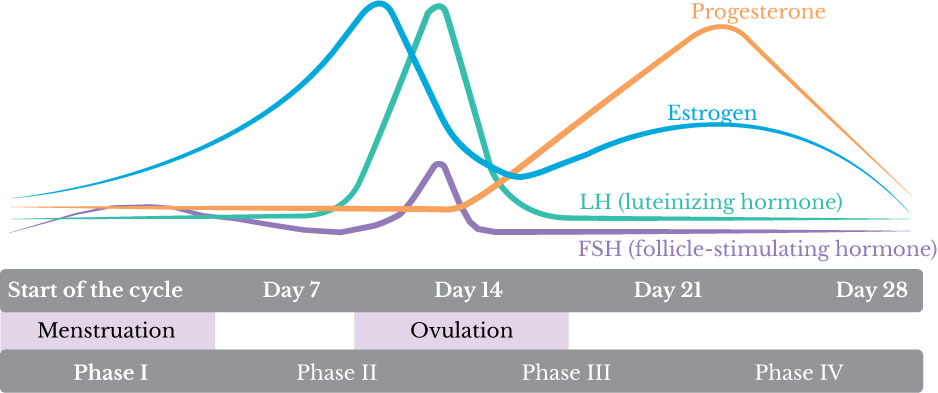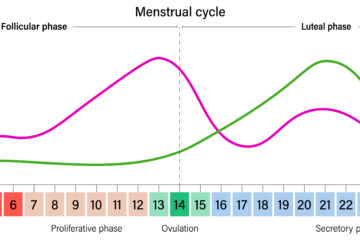Ladies Leverage Your Physiology!
It’s not in your head
Ladies, it’s not in your head- your physiology, training, and nutrition needs change throughout the month. It’s time to leverage this information to work smarter, not harder, for better results. The science related to training around the menstrual cycle is emerging, yet very exciting.

Ending underrepresentation
Since the passage of Title IX in 1972, the number of women participating in sports continues to skyrocket. But up until relatively recently, women have been grossly underrepresented in sports science, representing only about 39% of participants in exercise studies. Enter the ABT.she Panel and the ABT.she Initiative.
Why is it important to have a regular menstrual cycle?
You may be wondering: why focus on the menstrual cycle? Is it really that important? In a word, YES!
A regular period is known as the fifth vital sign for women. As an active woman, it’s easier for your menstrual cycle to go AWOL due to the stress of training, life, and challenges of keeping up with nutritional demands. An absence of a period is known as amenorrhea and is one of the signs of Relative Energy Deficiency in Sport (RED-S) (formerly known as the “female athlete triad”).
It is not normal or healthy to have irregular or missing periods. Note that are a few exceptions, such as if you are peri- or postmenopausal, have had a hysterectomy, or have an IUD that prevents you from getting a period. But generally, if you are amenorrheic or have irregular cycles, your body is telling you to pay attention–and that there’s an opportunity to feel and perform better by resuming a healthy cycle.
An irregular menstrual cycle is associated with many health problems. Some of these issues are short term: studies done recently (2018-2020) establish that swimmers who became amenorrheic were slower on average than women who maintained their period throughout the season. Other problems can be more permanent, including depression, anemia, osteoporosis, heart disease, and stroke (Vitti, 2020). In short, if you want optimal health and performance, a regular cycle is essential. Our ABT.she Panel can help you stay far away from underfueling and overtraining, which can lead to problems with your menstrual cycle.
Training around the menstrual cycle
Relatedly, even when women have a regular menstrual cycle, sometimes they aren’t feeling or performing at their best. Many female athletes have suboptimal or imbalanced levels of key biomarkers (including hormones) and don’t realize it until they get symptomatic and feel like something isn’t right. Symptoms usually don’t arise until things get on the fringes of “normal” and far away from optimal. By understanding underlying imbalances, we can help you feel and perform better. Think of it like plugging holes in a bucket. You can be pouring all the water you want into the bucket (training and nutrition), still, unless you plug the holes (fix any hormonal or biomarker imbalances), you won’t be able to fill the bucket (feel good and perform your best).

How does the menstrual cycle affect blood biomarkers?
Where a woman is in her menstrual cycle, or if she is on hormonal birth control, can impact blood testing results and analysis.
Several blood biomarkers change throughout a woman’s menstrual cycle. Women lose about 16 mg of iron per period, which equates to about 0.4-0.5% of total body iron. Although it may seem small, this can impact our iron status markers and make them appear lower during the first week of your cycle. Other micronutrients tend to wane as the cycle progresses. For example, magnesium and zinc are used to build up the uterine lining so that levels can be relatively low by the end of the cycle.
The ABT.she Panel allows us to consider where a female athlete is in her menstrual cycle when considering optimal levels of blood biomarkers and providing recommendations to improve them. For consistent results, Athlete Blood Test encourages women who are not on hormonal birth control to test on or about day three (3) of their cycle (the third day of your period). This allows us to compare month to month and test to test, especially when analyzing female sex hormones: estrogen, progesterone, luteinizing hormone (LH), and follicle-stimulating hormone (FSH).
If you are using hormonal birth control (pill, IUD, shot, patch, ring, etc.) you can still order an ABT.she panel and can test at any point during the month (instead of day 3 of your cycle). However, because your birth control drives your hormone levels and they aren’t your natural hormone levels, the information we (and you) can glean from the additional four hormones is limited. We recommend you consider a Gold panel instead.
Below is a quick summary of each of the four hormones in the ABT.she Panel and why they are important:
- Estrogen: Estrogen often gets all the attention when people talk about female hormones. It’s the dominant hormone in the first half of the menstrual cycle and is produced by the ovaries. Estrogen has many functions, for example, increasing insulin sensitivity, reducing inflammation, helping you feel full after meals, limiting muscle damage (hello faster recovery and less soreness!), and prepares your body to ovulate. These changes can impact how your body absorbs nutrients and responds to training. For example, estrogen spares carbohydrates and allows the use of free fatty acids for energy. This means it’s more difficult to tap into the higher intensities and use glycogen during training with higher estrogen levels.
- Progesterone: Progesterone counteracts many of estrogen’s effects. One aspect that impacts athletes is fluid retention and sodium loss. Progesterone causes greater sodium loss, a higher sweat rate, faster breathing, increases metabolic rate, and decreases insulin sensitivity. This makes carb-loading more difficult/less efficient in the luteal (second half) of your cycle.
- LH & FSH: LH stimulates the ovaries to produce estrogen, and FSH stimulates the growth of the ovarian follicle for ovulation. FSH also increases estrogen production. Together, LH and FSH are the keys to healthy ovulation and cycle. If LH and FSH don’t rise and reach a certain threshold, you won’t ovulate or have a regular cycle. Elevated levels of LH and FSH before menopause may be a sign that a woman is approaching menopause. LH and FSH are working overtime to try to stimulate ovulation.
The ABT.she Initiative
The ABT.she Panel is an amazing new tool in the female athlete’s toolbelt. But I’m not just excited about the ABT.she Panel as a product. I am excited about what it represents. The ABT.she Panel is the cornerstone of Athlete Blood Test’s ABT.she Initiative: Athlete Blood Test’s concerted effort to help female athletes thrive.
The ABT.she Initiative is cutting-edge science combined with empowerment. It is purpose-driven, science-powered, female-focused.
So what the heck is it?
It’s part of a movement to support women in sport. The ABT.she Initiative aims to increase the knowledge of the sports science community about female physiology. With every ABT.she Panel, Athlete Blood Test is gathering new data and comparing it to new research, making the analysis and recommendations that you receive better and more relevant. In doing so, they are advancing the science of human performance, and specifically, female athletic performance.
What is the ABT.she Panel and how is it unique?
Athlete Blood Test’s ABT.she blood analysis panel empowers women to understand their physiology better, so we can excel in our physical undertakings, whether that’s a 5k, marathon, Ironman triathlon, century ride, soccer game, or spin class.
The ABT.she Panel is a blood panel and analysis designed specifically for women, by women. The ABT.she Panel looks at your blood biomarkers (i.e., iron, B12) and female-specific sex hormones (estrogen, progesterone, luteinizing hormone (LH), and follicle-stimulating hormone (FSH)) and integrates them into the analysis and recommendations. It takes into account where you are in your menstrual cycle when analyzing whether your biomarker levels are optimal, and if not, how you can get them there.
Many other blood analyses don’t account for female-specific hormones or how they impact a woman’s other blood biomarkers. Ignoring the influence of hormones and their impact on other biomarkers can lead to an incomplete picture of what’s really going on in a female athlete’s body. Adding in four female-specific hormones allows Athlete Blood Test to give better training, nutrition, and recovery recommendations. ABT.she integrates these sex-specific biomarkers and insights into our analysis and provides action points, so you aren’t left guessing or trying to put the pieces together yourself.
By way of example, one athlete who recently had an ABT.she test had a magnesium level within the ideal range for athletes, however, it was at the low end. A computer algorithm or other analyses may see this result as entirely normal and given this athlete the green light. But magnesium decreases throughout the menstrual cycle (as do other nutrients), so her magnesium level later in the month likely wouldn’t be enough to support her training, so we recommended looking at nutrition or supplementation toward the end of her cycle. Bottom line, if you don’t consider a woman’s cycle and her birth control method (if she’s using one), some biomarkers may seem abnormal when in fact, they’re okay, and vice versa. Something may seem fine when it’s suboptimal.
Follow along on Insta (@athletebloodtestcom) or Facebook (Athlete Blood Test) to join the conversation and see how the ABT.she Initiative develops and takes shape.
Key Takeaway:
The ABT.she Panel is a blood panel and analysis designed specifically for women, by women. Ignoring the influence of hormones and their impact on other biomarkers can lead to an incomplete picture of what’s really going on in a female athlete’s body. Training around the menstrual cycle is an emerging yet exciting field.
Dr. A’nna, Chief Research Scienctist at Athlete Blood Test

Dr. A’nna strives to inspire people to optimally fuel their bodies to achieve their best and have a positive impact on the world. She is the only combined Ph.D./RD specializing in sports performance nutrition in the world with all Ivy League degrees and the Chief Research Officer at AthleteBloodTest.
Dr. A’nna aims to cultivate a world of healthy athletes who understand nutrition and know how to leverage their physiology to get the best results in sports and life. You can reach her at [email protected] or on Instagram @drannaroby.
Photo cred by HowToGym on Unsplash and Mark DeYoung on Unsplash


